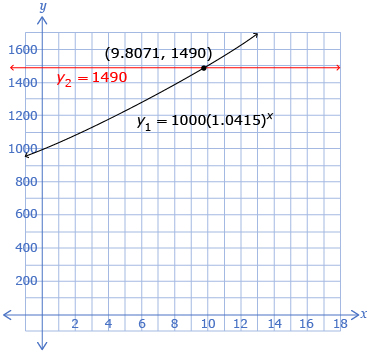Module 6: Lesson 2
Self-Check 3
- “Your Turn” from “Example 3” on page 363 of the textbook
To solve this question the compound interest formula will need to be used.
A = 1490
P = 1000

n = ?
Thus, substituting the known values into the compound interest formula gives the following:

This question can be solved by using either a systematic trial or by graphing. A possible solution to the systematic trial is shown.
Try n = 2. (1.0415)2 = 1.0847…, which is less than 1.49.
Try n = 4. (1.0415)4 = 1.1766…, which is less than 1.49.
Try n = 8. (1.0415)8 = 1.384 44…, which is less than 1.49.
Try n = 12. (1.0415)12 = 1.628 96…, which is greater than 1.49. Thus, n is between 8 and 12.
Try n = 10. (1.0415)10 = 1.5017…, which is greater than 1.49. Thus, n is between 8 and 10.
Try n = 9. (1.0415)9 = 1.441 89…, which is less than 1.49. Thus, it will take 10 pay periods for $1000 to reach $1490. This means that (because there are 2 compound periods per year) it will take 5 yr to reach $1490.
The solution that can be obtained by using graphing technology follows:

Thus, the approximate solution is x = 9.8071. Because the number of pay periods must be a whole number, n = 10 pay periods. This means that (because there are 2 compound periods per year) it will take 5 yr to reach $1490.
© 2012 Alberta Education